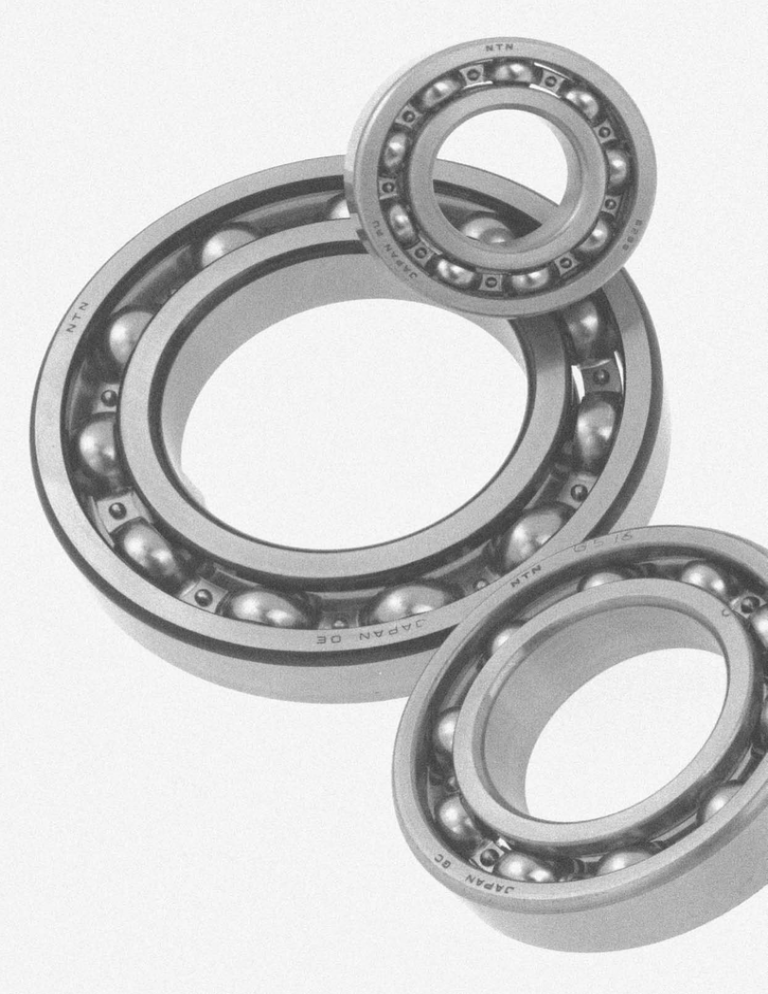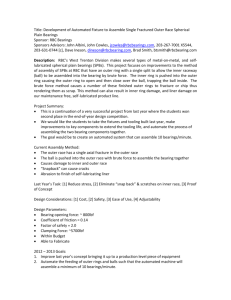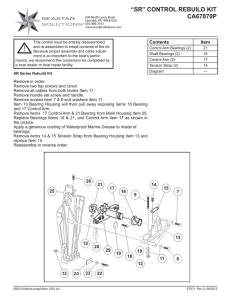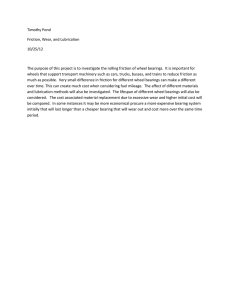Deep Groove Ball Bearings
advertisement

●Deep Groove Ball Bearings Open type Shielded type Sealed type (non-contact) Expansion Compensating Bearing 1. Design features and special characteristics Deep groove ball bearings are very widely used. A deep groove is formed on each inner and outer ring of the bearing enabling them to sustain radial and axial loads in either direction as well as well as the complex loads which result from the combination of these forces. Deep groove ball bearings are suitable for high speed applications. In addition to unsealed bearings, deep groove ball bearings include ball bearings with greased sealed inside (sealed or shielded) and bearings with a snap ring that simplify structure around the bearing and design. Table 1 shows the construction and special characteristics of various sealed deep groove ball bearings. Table 1 Sealed ball bearings: construction and characteristics Shielded type Sealed type Type, code no. Non-contact type ZZ Non-contact type LLB Contact type LLU Low torque type LLH ¡Metal shield plate is affixed to outside ring; inner ring incorporates a V-groove and labyrinth clearance. ¡Outer ring incorporates synthetic rubber molded to a steel plate; seal edge is aligned with V-groove along inner ring surface with labyrinth clearance. ¡Outer ring incorporates synthetic rubber molded to a steel plate; seal edge contacts V-groove along inner ring surface. ¡Basic construction the same as LU type, but specially designed lip on edge of seal prevents penetration by foreign matter; low torque construction. Torque Low Low Rather high Medium Dust proofing Very good Better than ZZ-type Excellent Much better than LLB-type Water proofing Poor Poor Very good Very good High speed capacity Same as open type Same as open type Limited by contact seals Much better than LLU-type Allowable temp.range 1 Depends on lubricant -25 ℃∼120 ℃ -25 ℃∼110 ℃ -25 ℃∼120 ℃ Construction Performance comparison 1 Please consult NTN Engineering about applications which exceed the allowable temperature range of products listed on this table. Note : This chart lists double shielded and double sealed bearings, but single shielded (Z) and single sealed (LB, LU, LH) are also available. Grease lubrication should be used with single shielded and single sealed bearings. B-5 ●Deep Groove Ball Bearings 2. Standard cage types As shown in Table 2, pressed cages are generally used in deep groove ball bearings. Machined cages are however used for large bearings and high-speed bearings. advantage is a large reduction in the occurrence of outer ring creeping. (1) Allowable load Maximum allowable load Cp (refer to the table of boundary dimensions) has been determined in accordance with outer ring strength; therefore, it is necessary to select a bearing with a maximum allowable load greater than the largest anticipated bearing load. Table 2 Standard cage for deep groove ball bearings Bearing series 67 68 69 160 60 62 63 64 Pressed cages Machined cages 6700∼ 6706 6800∼ 6834 6900∼ 6934 16001∼16052 6000∼ 6052 6200∼ 6244 6300∼ 6344 6403∼ 6416 ― 6836∼ 68/600 6936∼ 69/500 16056∼ 16072 6056∼ 6084 ― ― ― (2) Housing and bearing fit Table 3 shows the recommended fits for bearings with light metal alloy housings. In cases where the bearing is going to be interference fit with the housing, it is very important not to damage the high polymer material. Therefore it is essential that the lip of the housing diameter be given a 10˚–15˚ chamfer as shown in Fig. 2. Furthermore, as shown in Fig. 2, it is also advisable to apply the interference fit using a press in order not force the bearing into the housing in a misaligned position. (Fig. 2) 3. Other bearing types 3. 1 Bearings with snap rings Some bearings accommodate a snap ring which is attached along the outer diameter of the outer ring. By using snap rings, positioning in the axial direction is possible and housing installation is simplified. In addition to open type, shielded and sealed types are also manufactured. Consult NTN Engineering. (3) Radial internal clearance Radial internal clearance are the same as those for standard deep groove ball bearings. With standard fit and application conditions, a C3 clearance is used. 3. 2 Expansion compensating bearings (creep prevention bearings) Table 3 Recommended fits for outer ring and housing bore The boundary dimensions of expansion compensating deep groove ball bearings are the same as for standard bearings, but formed high polymer material with a high expansion rate is provided in the grooves on the outer circumference of the outer ring (see Fig. 1) . Due to the extremely small difference of thermal expansion attained between the fitted surfaces of the high polymer equipped outer ring and the light alloy bearing housing, a good interference fit can be achieved with stable performance across a wide temperature range. Another Conditions High polymer material Load type, etc. Housing material Rotating outer ring load Rotating inner ring load; light load Direction indeterminate load; ordinary load Al alloy Mg alloy Other light alloys Rotating outer ring load; heavy load Direction indeterminate load; shock load Al alloy Mg alloy Other light alloys 0.5mm over Fig. 1. Expansion compensating bearings Suitable bearing Housing bore tolerance class Deep groove ball bearing H6 Cylindrical roller bearing Thickwalled type deep groove ball bearing N6 10° ∼15° Fig. 2. Fitting method and housing inner diameter chamfer B-6 ●Deep Groove Ball Bearings For more detailed information concerning this bearing and the availability of roller bearings contact NTN Engineering. AC bearing is suitable for applications where a "tight fit" is not possible but outer ring creeping exists under rotating load on outer ring. AC bearing can alsobe installed as a floating side bearing to accommodate expansion of shaft by heat as it can more axially. Before installing the bearing into the housing, high viscosity oil (base oil viscosity, 100 mm2 /s or more) or grease has to be applied to the space between two O-rings. This lubricant forms a thin oil layer on the bearing outer ring which prevents contact between the outer ring and housing, lowers the friction, and can minimize the occurrence of creeping by utilizing the friction force of the O-rings. (4) Allowable temperature range -20〜120˚C 3.3 Long-life bearings (TMB/TAB bearings) Boundary dimensions of long-life bearings are the same as those of standard deep groove ball bearings, but the bearings have special heat treatment that considerably extends life. These bearings are especially effective in countering short life due to the effects of infiltration by dust and other foreign matter. Features are as follows: ¡Load rating is the same as standard bearings, but life adjustment factor is a2 = 2.2 for TMB bearings and a2 = 3.6 for TAB. ¡TMB 62 series bearings used instead of place of standard 63 series bearings enabling lighter weight, more compact designs. ¡Reduction life under contaminated lubrication is minimal. Greater resistance to reduced wear life due to infiltration by dust and other matter. For dimensional specifications, handling procedures, and other detailed information concerning AC bearings, contact NTN Engineering. (1) Allowable load Allowable load Cp is set in considering outer ring strength maximum load on the bearing has to be lower than Cp. (2) Fit with housing Table 4 shows recommended fit with steel housing. 0.006D or larger Dimensions for these bearings are not listed in the dimensions table. For details, please contact NTN Engineering. 3.4 AC bearings (creep prevention bearings) AC bearings have the same boundary dimensions as standard bearings with the addition of two O-rings imbedded on the outside surface of the outer ring. (Fig. 3) φD G7 30˚ Oil Fig. 4. Design of housing Table 4 Dimensions and design O-ring Housing bore tolerance G7 Housing bore entrance chamfer Max. 30˚C Housing bore chamfer undercut 0.006D or larger 2.5μm Ra Housing bore surface roughness Housing bore roundness 1/2 of bearing housing dimension tolerance (3) Allowable temperature range -25 〜120˚C Fig. 3. AC bearing B-7



